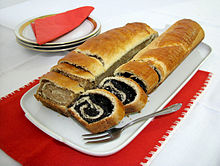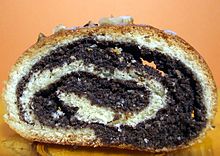- Poppy seed roll
-
The poppy seed roll is pastry consisting of a roll of sweet yeast bread (a viennoiserie) with a dense, rich, bittersweet filling of poppy seed. An alternative filling is a paste of minced walnuts.
It is a popular cuisine in other parts of Central Europe, Eastern Europe and in Israel as well. It is commonly eaten at Christmas and Easter time. It is traditional in several cuisines, including the Hungarian cuisine (beigli or bejgli[1]) Russian cuisine (bulochki s makom Russian: булочки с маком), Polish cuisine (makowiec), Lithuanian cuisine (aguonų vyniotinis), Croatian cuisine (makovnjača, orehnjača), Romanian cuisine (cozonac), and Austrian cuisine (Mohnkuchen or Mohnstriezel).
Contents
Ingredients
The dough is made of flour, sugar, egg yolk, milk or sour cream and butter, and yeast.[2] The dough may be flavored with lemon or orange zest or rum. The poppy seed filling[3] contains ground poppy seeds, raisins, butter or milk, sugar or honey, rum and vanilla. Sometimes sugar is substituted for a tablespoon of apricot jam, which is one of the most popular jams used in the Hungarian cuisine. The walnut roll filling contains raisins, rum, butter or milk, lemon rind and chopped walnuts. This filling may be spiced with cinnamon, nutmeg, clove or vanilla.[4]
The dough is at first quite heavy, stiff and dry, but with kneading and resting becomes very elastic and strong. It is rolled out into a large sheet, thick or thin depending on taste. One aesthetic principle is that the dough and filling layers should be equal thicknesses. Another is that more layers are better. The filling is spread over the dough, which is then rolled into a long cylinder or log. Traditional recipes usually involve brushing the log with the egg white left over from the yolk used in the dough. Other recipes use different washes, or an icing added after baking. The unbaked log is gently transferred to a sheet pan, left to rise, then baked until golden brown.
Christmas traditions
Hungarian Christmas sweets and pastries served at Christmas time are not numerous. In general no other pastries are served, and the traditional candy szaloncukor, large amounts of wrapped decorative fondant candies hung on the Christmas tree as a decoration, also consumed during the Christmas holidays. All Hungarian families serve both the walnut and the poppy seed rolls, often accompanied with fruit wines, like red currant wine.[citation needed]
Variants
The poppy seed filling is a paste of ground poppy seeds, milk, butter, sugar and/or honey, often with additional flavorings such as lemon zest and juice.[2] It may have raisins.[5] The walnut filling is a paste of ground walnuts, milk, butter, sugar, and raisins, often with additional flavorings such as coffee or orange zest.[2]
A very long roll may be bent so that it fits on a baking sheet; the result is called a patkó (Hungarian: horseshoe). Before baking, the roll may be given a wash of milk. The roll can be finished with an icing after baking, made of powdered sugar and lemon juice (or a glaze during baking). Usually it is brought from the kitchen already sliced.
In Hungarian cuisine the rolls, one with each filling, are served together. The combination is known as mákos és diós (poppy seed and walnut). However, in some English language cookbooks there may be no mention of the walnut filling, as if poppy seed were the only filling used.[6] Some other non-Hungarian food writers combine the poppy seeds and walnuts together in one filling.[7] Because Poland and Czech culture have intermingled, immigrants to America sometimes use the term "Kolache" to describe it.
See also
- Mohnstrudel (poppy seed strudel)
- Polish cuisine: Dessert
- Hamantash
- Tsoureki
- Kolacz
- Lokum
References
- ^ June Meyers Authentic Hungarian Heirloom Recipes Cookbook
- ^ a b c Dorcas Guild of the Magyar United Church of Christ, ed (1960). Hungarian recipes. Elyria, Ohio. pp. 44.
- ^ Mákos bejgli
- ^ Diós és Mákos bejgli with picture
- ^ Clayton, Bernard (2003). Bernard Clayton's New Complete Book of Breads (30 ed.). Simon and Schuster. p. 308–310. ISBN 0743234723. http://books.google.com/books?id=Nqbe0e6VUK0C&pg=RA6-PA308.
- ^ Beth Hensperger (2001). Bread for Breakfast. Ten Speed Press. pp. 81–83. ISBN 1580082130. http://books.google.com/books?id=49AedZjbufgC&pg=PP81.
- ^ Evelyn Birge Vitz (1985). A Continual Feast: A Cookbook to Celebrate the Joys of Family and Faith Throughout the Christian Year (1991 reprint ed.). Ignatius Press. pp. 138–139. ISBN 0898703840. http://books.google.com/books?id=hrdUYzuAO14C&pg=PA138.
External links
 Media related to Makowiec at Wikimedia CommonsCategories:
Media related to Makowiec at Wikimedia CommonsCategories:- Pastry with poppy seeds
- Christmas food
- Slavic cuisine
- Lithuanian cuisine
- Silesian cuisine
- Polish desserts
- Hungarian desserts
- Easter food
Wikimedia Foundation. 2010.


